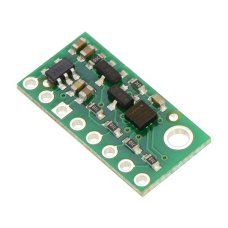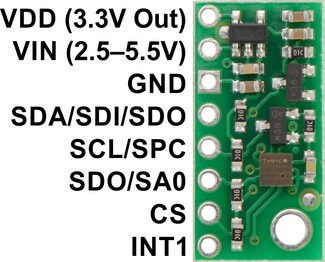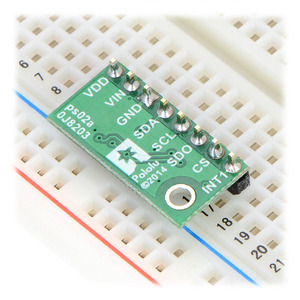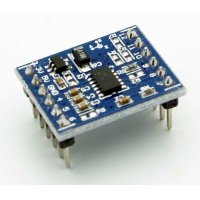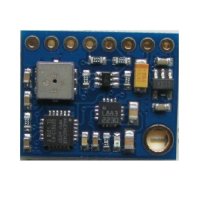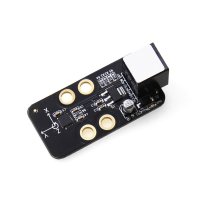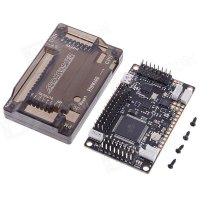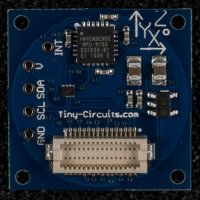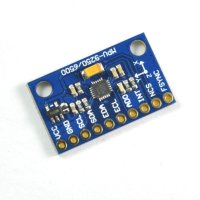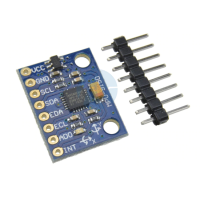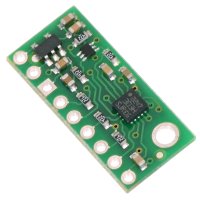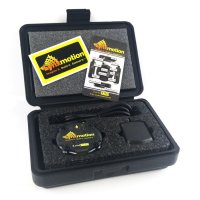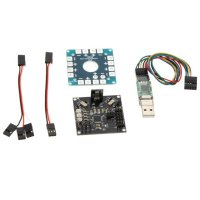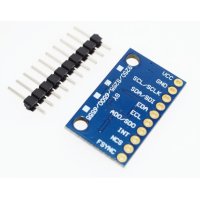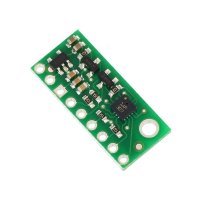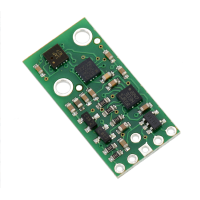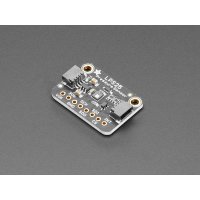Note: This product is replaced with LPS25HB
This board is a compact (0.4″ × 0.8″) carrier for ST’s LPS25H MEMS absolute pressure sensor, or barometer; we therefore recommend careful reading of the LPS25H datasheet (1MB pdf) before using this product. The LPS25H is a great IC, but its small, leadless, LGA package makes it difficult for the typical student or hobbyist to use. It also operates at voltages below 3.6 V, which can make interfacing difficult for microcontrollers operating at 5 V. This carrier board addresses these issues by incorporating additional electronics, including a 3.3 V voltage regulator and level-shifting circuits, while keeping the overall size as compact as possible. The board ships fully populated with its SMD components, including the LPS25H, as shown in the product picture.
Compared to the earlier LPS331AP, the LPS25H features improved accuracy and reduced noise in the output. The addition of a built-in FIFO (First In, First Out) buffer allows the sensor to store pressure readings for burst transmission, reducing overall power consumption by allowing the host processor to sleep longer between data requests. Alternatively, the FIFO can be configured to perform a running average of pressure readings to further decrease the output noise.
This LPS25H carrier board is pin-compatible with our LPS331AP carrier, but due to the removal of one of the interrupt pins on the LPS25H, the position of the mounting hole has changed relative to the remaining pins. The two sensors use the same I²C addresses, but some of their configuration register fields are different, so code written to interface with an LPS331 might need to be modified to work with an LPS25H.
The LPS25H features embedded temperature compensation and has many configurable options, including selectable resolutions, a choice of output data rates, several FIFO operating modes, and a programmable external interrupt signal. Its pressure output has an absolute pressure accuracy over temperature as low as ±0.2 mbar (0.02 kPa), with RMS noise of 0.01 mbar (0.001 kPa) in the highest-resolution mode with embedded filtering enabled. Pressure and temperature sensor data are available through a digital interface, which can be configured to operate in either I²C or SPI mode, and can be used for altimetry. (See the Sample Code section below for an Arduino library that can be used to turn this sensor into an altimeter.)
The carrier board includes a low-dropout linear voltage regulator that provides the 3.3 V required by the LPS25H, which allows the sensor to be powered from a 2.5 V to 5.5 V supply. The regulator output is available on the VDD pin and can supply almost 150 mA to external devices. The breakout board also includes a circuit that shifts the I²C/SPI clock and data in lines to the same logic voltage level as the supplied VIN, making it simple to interface the board with 5 V systems, and the board’s 0.1″ pin spacing makes it easy to use with standard solderless breadboards and 0.1″ perfboards.
Specifications
Included components
A 1×8 strip of 0.1″ header pins and a 1×8 strip of 0.1″ right-angle header pins are included, as shown in the picture below. You can solder the header strip of your choice to the board for use with custom cables or solderless breadboards, or you can solder wires directly to the board itself for more compact installations.
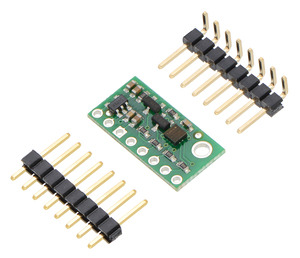 |
The board has one mounting hole that works with #2 and M2 screws (not included).
Using the LPS25H
Connections
Regardless of the interface being used to communicate with the LPS25H, its VIN pin should be connected to a 2.5 V to 5.5 V source, and GND should be connected to 0 volts. (Alternatively, if you are using the sensor with a 3.3 V system, you can leave VIN disconnected and bypass the built-in regulator by connecting 3.3 V directly to VDD.)
A minimum of two logic connections are necessary to use the LPS25H in I²C mode (this is the default mode): SCL and SDA. These pins are connected to built-in level-shifters that make them safe to use at voltages over 3.3 V; they should be connected to an I²C bus operating at the same logic level as VIN. The remaining pins are not connected to level-shifters on the board and are not 5V-tolerant, but our 4-channel bidirectional logic level shifter can be used externally with those pins to achieve the same effect.
To use the LPS25H in the default SPI mode, four logic connections are required: SPC, SDI, SDO, and CS. These should be connected to an SPI bus operating at the same logic level as VIN. The SPI interface operates in 4-wire mode by default, with SDI and SDO on separate pins, but it can be configured to use 3-wire mode so that SDO shares a pin with SDI.
|
|
Pinout
| PIN | Description |
|---|---|
| VDD | Regulated 3.3 V output. Almost 150 mA is available to power external components. (If you want to bypass the internal regulator, you can instead use this pin as a 3.3 V input with VIN disconnected.) |
| VIN | This is the main 2.5 V to 5.5 V power supply connection. The SCL/SPC and SDA/SDI level shifters pull the I²C and SPI bus high bits up to this level. |
| GND | The ground (0 V) connection for your power supply. Your I²C or SPI control source must also share a common ground with this board. |
| SDA/SDI/SDO | Level-shifted I²C data line and SPI data in line (also doubles as SDO in 3-wire mode): HIGH is VIN, LOW is 0 V |
| SCL/SPC | Level-shifted I²C/SPI clock line: HIGH is VIN, LOW is 0 V |
| SDO/SA0 | SPI data out line in 4-wire mode: HIGH is VDD, LOW is 0 V.This output is not level-shifted. Also used as an input to determine I²C slave address (see below). |
| CS | SPI enable (chip select). Pulled up to VDD to enable I²C communication by default; drive low to begin SPI communication. |
| INT1 | Programmable interrupt, a 3.3-V-logic-level output. This output is not level-shifted. |
Schematic diagram
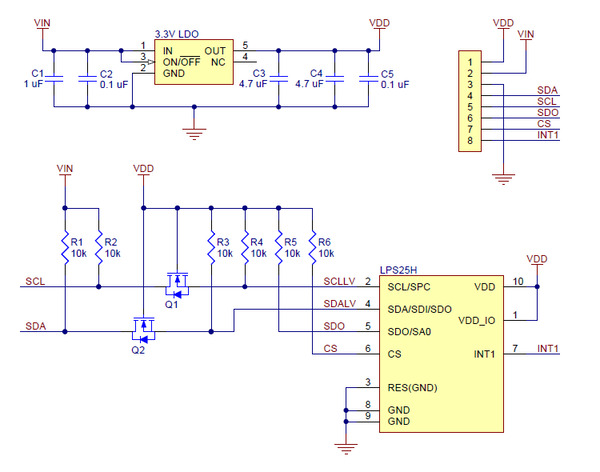 |
The above schematic shows the additional components the carrier board incorporates to make the LPS25H easier to use, including the voltage regulator that allows the board to be powered from a 2.5 V to 5.5 V supply and the level-shifter circuit that allows for I²C and SPI communication at the same logic voltage level as VIN. This schematic is also available as a downloadable PDF (162k pdf).
I²C communication
With the CS pin in its default state (pulled up to VDD), the LPS25H can be configured and its pressure reading can be queried through the I²C bus. Level shifters on the I²C clock (SCL) and data (SDA) lines enable I²C communication with microcontrollers operating at the same voltage as VIN (2.5 V to 5.5 V). A detailed explanation of the I²C interface on the LPS25H can be found in its datasheet (1MB pdf), and more detailed information about I²C in general can be found in NXP’s I²C-bus specification (1MB pdf).
In I²C mode, the sensor’s 7-bit slave address has its least significant bit (LSb) determined by the voltage on the SA0 pin. The carrier board pulls SA0 to VDD through a 10 kΩ resistor, making the LSb 1 and setting the slave address to 1011101b by default. If the pressure sensor’s selected slave address happens to conflict with some other device on your I²C bus, you can drive SA0 low to set the LSb to 0.
The I²C interface on the LPS25H is compliant with the I²C fast mode (400 kHz) standard. In our tests of the board, we were able to communicate with the chip at clock frequencies up to 400 kHz; higher frequencies might work but were not tested.
SPI communication
To communicate with the LPS25H in SPI mode, the CS pin (which the board pulls to VDD through a 10 kΩ resistor) must be driven low before the start of an SPI command and allowed to return high after the end of the command. Level shifters on the SPI clock (SPC) and data in (SDI) lines enable SPI communication with microcontrollers operating at the same voltage as VIN (2.5 V to 5.5 V).
In the default 4-wire mode, the pressure sensor transmits data to the SPI master on a dedicated data out (SDO) line that is not level-shifted. If the SPI interface is configured to use 3-wire mode instead, the SDI line doubles as SDO and is driven by the LPS25H when it transmits data to the master. A detailed explanation of the SPI interface on the LPS25H can be found in its datasheet (1MB pdf).
Sample Code
We have written a basic Arduino library for the LPS25H that makes it easy to interface this sensor with an Arduino. The library makes it simple to configure the LPS25H and read the raw pressure data through I²C, and it provides functions for calculating altitude based on the measured pressure for those looking to use this sensor as an altimeter.
Protocol hints
The datasheet provides all the information you need to use this sensor, but picking out the important details can take some time. Here are some pointers for communicating with and configuring the LPS25H that we hope will get you up and running a little bit faster:
| Electrical Specifications | |
| Minimum Operating Voltage | 2.5 V |
| Maximum Operating Voltage | 5.5 V |
| Physical Attributes | |
| Weight | 0.5 g |
| Size | 0.4″ × 0.8″ × 0.1″ |
Pololu 2724 LPS25H Pressure/Altitude Sensor Carrier with Voltage Regulator
- Brand: Pololu
- Product Code:Pololu-LPS25H-Pressure-Altitude-Sensor
- Reward Points:6
- Availability:Discontinued
-
रo 622.00
- Price in reward points:622
Related Products
3-Axis Accelerometer Board (MMA7361) cum Angle Sensor
3-Axis Accelerometer Board (MMA7361) for Arduino etc. This Accelerometer module is based on the..
रo 320.00 रo 402.00
MPU 6050 + HMC5883L + BMP085 Flight Control 10 DOF Sensor Module
GY-88 MPU - 6050 HMC5883L BMP085 ( Acceleration + Gyroscope + Electronic Compass + Barometer pressur..
रo 1,875.00
Me 3-Axis Accelerometer and Gyro Sensor
Me 3-Axis Accelerometer and Gyro Sensor is a motion processing module. It can use to measure the ang..
रo 2,370.00
ArduPilot Mega 2.6
This is the new APM 2.6 autopilot module. The sensors are exactly the same as with APM2.5+, however ..
रo 3,553.00
TinyShield 9-Axis IMU
This TinyShield lets you measure 9 degrees of freedom (9DOF) with your TinyDuino and features the ST..
रo 2,137.00
9-Axis Gyro + Accelerator + Magnetometer Sensor Module MPU-9250
9-Axis Gyro + Accelerator + Magnetometer Sensor Module MPU-9250 Features and Specification..
रo 420.00 रo 540.00
9-Axis Gyro + Accelerator + Magnetometer Sensor Module/ Kit MPU-9150
The MPU-9150 is the world's first 9-axis MotionTracking device designed for the low power, low cost,..
रo 1,060.00 रo 1,390.00
Electric Scooter Self Balancing with Bluetooth
4400mAh Bluetooth Two Wheel Self Balancing Scooter - EU PLUG Note: 1. Product photograp..
रo 32,985.00
Pololu 2127 LSM303D 3D Compass and Accelerometer Carrier with Voltage Regulator
LSM303D 3D Compass and Accelerometer Carrier with Voltage Regulator The LSM303D combines a digit..
रo 622.00
Lynxmotion Quadrino Nano Drone/UAV Flight Controller (with GPS)
The Lynxmotion Quadrino Nano was created as a collaboration between FlyingEinstein and t..
रo 12,945.00
Navio2 Autopilot Kit for Raspberry Pi 2 / 3
Autopilot kit for for Raspberry Pi 2 & 3 GPS/Glonas/Beidou U-blox M8N receiver ..
रo 28,290.00
9-Axis Gyro + Accelerator + Magnetometer Sensor Module MPU-9255
9-Axis Gyro + Accelerator + Magnetometer Sensor Module MPU-9255 Features and Specific..
रo 1,047.00
Pololu 2126 LPS331AP Pressure/Altitude Sensor Carrier with Voltage Regulator
This carrier for ST’s LPS331AP digital barometer measures pressures from 260 mbar to 1260 ..
रo 391.00
Pololu 2739/2469/2470 AltIMU-10 Gyro, Accelerometer, Compass, and Altimeter (L3GD20H, LSM303D and LPS331AP/ LPS25H Carrier)
The Pololu AltIMU-10 v3/v4 is an inertial measurement unit (IMU) and altimeter that features the sam..
रo 3,581.00 रo 3,730.00
Adafruit 4530 LPS25 Pressure Sensor - STEMMA QT / Qwiic - LPS25HB
This absolute pressure sensor, ST LPS25HB can quickly and easily measure this air pressure, useful w..
रo 1,074.00
Tags: LPS25H, Pressure, Altitude, Sensor, Carrier, Voltage, Regulator

